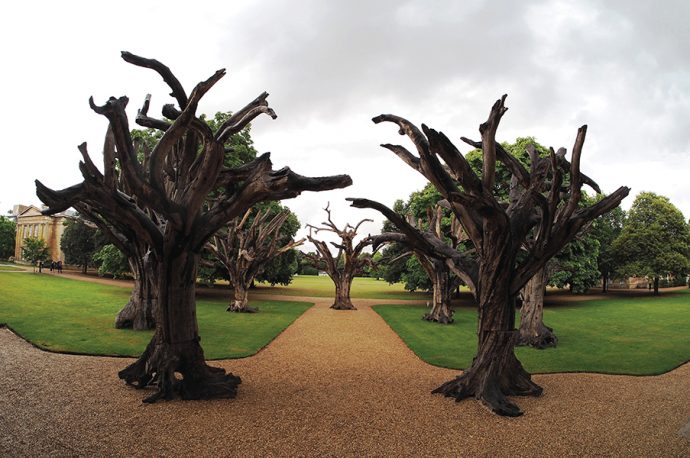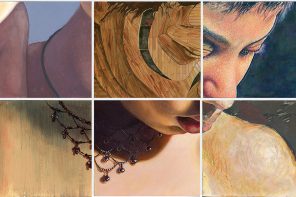Chinese art, the oldest existing cultural tradition in the world, has been achieving distinction for some 5,000 years.
Despite the Communist government ruthlessly stymieing creativity from 1950 to ’80 with imposed social realism and assigned propagandistic subjects for mass production, ancient and contemporary Chinese art are among the hottest and most dynamic sectors of the international market.
In recent decades, Chinese contemporary art in particular has been raking in record prices at home and internationally. The Economist recently reported that China has become the “darling” of the world art market, overtaking France as the third market after the United States and Britain. At art auctions in 2007, five of the 10 best-selling living artists were Chinese. A 59-year old painter, Zhang Xiaogang, alone sold a total of $56.8 million.
Zhang, one of China’s earliest contemporary painters, is a Symbolist and Surrealist known for his stylized portraits. The most striking difference between contemporary and traditional painters is that their “avant-garde art” is as much about themselves as individuals as it is about China, which has not always suited the government. Although many internationally acclaimed Chinese artists — including the controversial Ai Weiwei, Cai Jin and Zhu Yu — have successfully exhibited their works in New York, they are still restricted in China where some have even been arrested and had their exhibitions closed.
It’s a reminder that free artistic expression, which is now springing up spontaneously all over China, has not come easy. The most difficult period for creative art was during the Cultural Revolution (1966 to ’76) when Mao Zedong ordered the destruction of “The Four Olds,” including ancient art. Anything other than social realism was under suspicion and true artists were forced underground.
American-style individualism, fostering the freedom of self-exploration, has never been accepted in traditional Chinese culture. China, as a collective society, believes the needs of a group are far more important than individual needs. Actually, the Chinese term for individualism (gerenzhuyi) suggests an egotistical obsession with oneself instead of holding the family and community first.
These disparate attitudes toward individuality resulted from different philosophies of governance. In China, social order and harmony in the community are considered central political values achieved by obeying the ancient hierarchy in which everyone adheres to Confucius’ first imperative: “Know thy place.” Historically, China’s view was that the Chinese empire, known as “The Middle Kingdom,” was located in the center of the civilized universe. Whatever lay outside of the Chinese empire was considered “barbaric.”
The Chinese take pride in their ancient civilization. In his book “The Governance of China,” President Xi Jinping claimed that “China’s continuing civilization is not matched by anything on earth but is a unique achievement in world history.”
The United States views itself as the vanguard of a democratic civilization. Perhaps the main difference is the passion for freedom of the individual, which is enshrined in The Declaration of Independence. The core of American political doctrine proclaims that “all men are created equal, that they are endowed by their Creator with certain unalienable Rights, that among these are Life, Liberty and the pursuit of Happiness.” The Chinese equivalent of Patrick Henry’s “give me liberty or give me death” might be “give me a harmonious community or give me death.” This applies to both Chinese domestic society and world affairs.
Americans and Chinese also view the past, present and future quite differently. On July 4, Americans proudly celebrated their 241st birthday. This passage of time is no more than the average time of one of China’s 11 major dynasties spanning a history of five millennia.
Since World War II, the United States has spent nearly three decades as the world’s most powerful country but recently, especially since President Donald J. Trump withdrew from the Paris Climate Accord and the Trans-Pacific Partnership, China has challenged this. Just as Americans realize they must improve their understanding of China, Chinese are endeavoring to improve their understanding not only of the United States and the outside world but of themselves as unique individuals.
The forces of change may be reshaping the psyche of Chinese youth. China is not only challenging the West in the art market but is among the fastest growing economies and a leader in research and development. Creative artists are bored with conformity and are embracing individualism. “Slash youth,” or xiegang, has become a new term in China. It refers to young people who are breaking the mold, mainly motivated by more freedom and financial instability. They no longer have to “Know thy place” but think differently, compete with their peers and do multiple jobs at the same time. According to Hu Xiaowu, deputy director of the Institute of Urban Science at Nanking University (where I once studied), young Chinese believe “slash careers” are becoming a way to combine economic security with work that matches people’s passions. This refreshing attitude encourages modern artists to consider their individuality, explore their own minds and produce original art.




